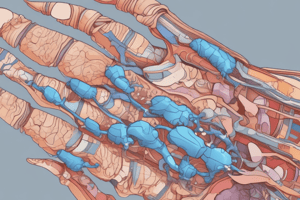Podcast
Questions and Answers
What is a key difference between NSAIDs and glucocorticoids in the treatment of RA?
What is a key difference between NSAIDs and glucocorticoids in the treatment of RA?
- Glucocorticoids prevent disease progression and joint damage (correct)
- NSAIDs have a shorter duration of treatment
- NSAIDs are more effective in reducing inflammation
- Glucocorticoids are more effective in reducing pain
What is the recommended duration of low-dose glucocorticoid treatment in RA?
What is the recommended duration of low-dose glucocorticoid treatment in RA?
- 3 months or less (correct)
- 1 year or less
- 6 months or less
- No time limit
What is the purpose of concomitant folic acid administration with methotrexate therapy?
What is the purpose of concomitant folic acid administration with methotrexate therapy?
- To reduce the dose of methotrexate
- To reduce the risk of folate-depleting reactions (correct)
- To enhance the bioavailability of methotrexate
- To increase the efficacy of methotrexate
What is the maximum weekly dose of methotrexate in RA treatment?
What is the maximum weekly dose of methotrexate in RA treatment?
What is the primary goal of initiating disease-modifying therapy immediately in RA treatment?
What is the primary goal of initiating disease-modifying therapy immediately in RA treatment?
Why is methotrexate considered the csDMARD of choice in RA?
Why is methotrexate considered the csDMARD of choice in RA?
What type of therapy may be necessary for severe RA with extensive joint erosions?
What type of therapy may be necessary for severe RA with extensive joint erosions?
What is the benefit of intra-articular administration of glucocorticoids in RA?
What is the benefit of intra-articular administration of glucocorticoids in RA?
What is the purpose of 'bridge therapy' in RA treatment?
What is the purpose of 'bridge therapy' in RA treatment?
What type of nonpharmacologic therapy may help patients with RA preserve joint function?
What type of nonpharmacologic therapy may help patients with RA preserve joint function?
What is the primary benefit of NSAIDs in RA treatment?
What is the primary benefit of NSAIDs in RA treatment?
What is the classification of azathioprine, cyclosporine, and minocycline in RA treatment?
What is the classification of azathioprine, cyclosporine, and minocycline in RA treatment?
What percentage of cases of juvenile idiopathic arthritis are systemic?
What percentage of cases of juvenile idiopathic arthritis are systemic?
What is the typical pattern of fever in systemic juvenile idiopathic arthritis?
What is the typical pattern of fever in systemic juvenile idiopathic arthritis?
Which type of juvenile idiopathic arthritis is more common in girls?
Which type of juvenile idiopathic arthritis is more common in girls?
What is the primary goal of treatment in rheumatoid arthritis?
What is the primary goal of treatment in rheumatoid arthritis?
What is essential for reducing disease progression and preventing joint damage in rheumatoid arthritis?
What is essential for reducing disease progression and preventing joint damage in rheumatoid arthritis?
What type of drugs are the mainstay of rheumatoid arthritis treatment?
What type of drugs are the mainstay of rheumatoid arthritis treatment?
What is the initial treatment of choice for moderate to high disease activity in rheumatoid arthritis?
What is the initial treatment of choice for moderate to high disease activity in rheumatoid arthritis?
Why should combination therapy involving bDMARDs or tsDMARDs be avoided?
Why should combination therapy involving bDMARDs or tsDMARDs be avoided?
Flashcards are hidden until you start studying
Study Notes
Nonpharmacologic Therapy
- All patients should receive education about nonpharmacologic and pharmacologic measures to help manage RA and JIA
- Occupational and physical therapy can help patients preserve joint function
- Patients should be counseled about stress management
- Surgery to replace or reconstruct the joint may be necessary if the disease has progressed to a severe form with extensive joint erosions
Pharmacologic Therapy
- The current standard of care for RA treatment is to initiate disease-modifying therapy immediately
- "Bridge therapy" or short-term use of certain medications can provide symptomatic relief until the disease-modifying drug reaches its therapeutic effect
- NSAIDs and glucocorticoids are commonly used for bridge therapy
NSAIDs
- Provide analgesic and anti-inflammatory benefits for joint pain and swelling
- Do not prevent joint damage or change the underlying disease
- Selection of an NSAID depends on patient-specific factors, including cardiovascular risk and potential for GI-related adverse events
Glucocorticoids
- Low-dose glucocorticoid treatment can reduce inflammation through inhibition of cytokines and inflammatory mediators
- Can prevent disease progression
- Recommended duration is 3 months or less to avoid significant adverse reactions, especially bone loss leading to osteoporosis
- Intra-articular administration of glucocorticoids may be considered in RA for rapid control of inflammation
Conventional Synthetic (cs)DMARDs
- Methotrexate is the csDMARD of choice in RA due to its efficacy and safety profile
- Once-weekly doses should be initiated and increased steadily until the patient has symptomatic improvement or a maximum dose of 20 mg/week is reached
- Concomitant folic acid is given to reduce the risk of folate-depleting reactions induced by methotrexate therapy
Treatment
- Desired outcomes of treatment in RA include reducing or eliminating pain, reducing disease activity, protecting articular structures and function, controlling systemic complications, and improving/maintaining quality of life
- Early diagnosis and early aggressive treatment are necessary to reduce disease progression and prevent joint damage
DMARDs
- DMARDs are the mainstay of RA treatment because they modify the underlying disease process
- The umbrella term DMARD includes conventional synthetic (csDMARD), biologic (bDMARD), and targeted synthetic (tsDMARD)
- Methotrexate is the initial treatment of choice for moderate to high disease activity
- Combination therapy may be initiated at the time of diagnosis, but combination bDMARDs or tsDMARDs should be avoided due to the increased risk of infection
Studying That Suits You
Use AI to generate personalized quizzes and flashcards to suit your learning preferences.




